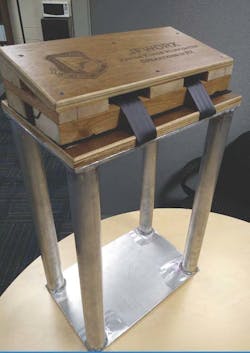The Air Force and its military and civilian employees are serious about cutting costs and preventing injuries. In a project that does both, the Air Force Research Laboratory’s Junior Force Warfighter Operations (JFWORX) team at Wright-Patterson Air Force Base in Ohio has almost completed a recent project, the redesign of a piece of aircraft support equipment. (JFWORX is a group of volunteer scientists and engineers from various disciplines around the lab working to create rapid solutions for near-term warfighter needs.)
The support gear is not high-tech or very glamorous. In fact, it’s known around the Air Force as the “milk stool.” It is a wooden support that is part of the plane’s equipment that gets placed under the rear loading ramp of a C-130 Hercules aircraft for stability during loading. Without it, a heavy load on the ramp can push the front of the plane up off the ground like a seesaw. The stool needs to support up to 72,000 lb and be a firm, structural support point under the ramp to keep the aircraft safe and stable during loading.
The current milk stool weighs about 85 lb and requires two people to move and position it under the loading ramp. C-130 crews only include one loadmaster, so finding another person to safely move and position the milk stool causes time delays or forces the loadmaster to move it alone, risking injury. Due to the large and awkward size, the stool is cumbersome and difficult to move around items that have already been loaded onto the plane.
The Junior Force Warfighters Operations in the Air Force Research Laboratory Materials and Manufacturing Directorate hope to patent the new and improved milk stool for C-130 aircraft. (U.S. Air Force photo/J.D. Bales)
In 2011, a group of Air Force Academy cadets attempted to design a lightweight stool. The design didn’t make the transition from prototype to product, but the cadets’ work has been extremely useful to the JFWORX team.
The JFWORX team chose aluminum tubing and plates as the main structural members of the new stool because of its strength, low cost, and corrosion resistance. Aluminum is also widely available, so any well-equipped Air Force maintenance shops in the world could repair or replace the new design.
The materials for the new milk stool cost approximately $125, a slight increase over approximately $75 for the legacy design. but the new milk stool weighs approximately 30 lb, so the cost increase will quickly be offset by fuel savings from the decrease in weight. The annual savings equate to approximately $375,000 for the Air Force and up to $1.7 million if the new milk stool is adopted across the entire C-130 fleet.
Five prototypes have been constructed over three months, each one iteratively building on advances in design and construction from the previous one. This let the team to rapidly improve the design and quickly surpass customer requirements, taking three months to build and test five prototypes. The current design will be delivered to Hurlburt Field, a Florida airfield that is part of Eglin AFB, after load testing is completed. After further testing in the field, the new stool could go into production as early as 2019.


